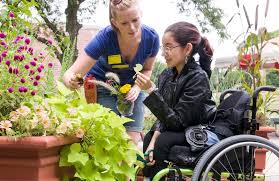 Horticultural therapy is the process that happens when a person interacts with plants to improve the quality of their life. Whether a person is encumbered by physical limitations, ill health, or just modern-day stress an active involvement with plants can offer many physical, mental, and emotional benefits.
Horticultural therapy is the process that happens when a person interacts with plants to improve the quality of their life. Whether a person is encumbered by physical limitations, ill health, or just modern-day stress an active involvement with plants can offer many physical, mental, and emotional benefits.
Tips for making your garden more user-friendly
Design
Locate the plants that need the most care near the house. Consider ways to make frequent chores such as watering and weeding less time-consuming and physically demanding. Overall make your garden easy to get to, easy to move around in, and set everything up to be within easy reach.
Needs
What are your needs? Maybe for you less bending, lifting, or digging if those movements are difficult or causing pain or more of these activities to build strength, endurance, and flexibility? What kinds of plants do you want to grow – ornamentals, natives, food crops or a combination of all of these? Be careful to match your goals and needs with the needs of the plants. Plants have their own particular needs for water, sun, and care.
Containers
There are many different styles of raised beds and containers to choose from. Get ones that are at the right height and width for your needs and the needs of the plants. Plants can be grown at different heights through creative placement on tables, walls, pulleys, hangers, trellises, etc.
Potting table
One of the great joys of gardening is propagating and potting up plants. The table should be at a comfortable height for your needs. Keep your potting materials within easy reach.
Safety
Consider strategically placed grab bars, handrails, and seating areas. A raised edging along flat, wide paths help guide wheels, walkers, and canes.
Tools
Buy or adapt tools that increase your ability to enjoy the process. Tools can be kept in a bucket where you need them or rolled along with you in a wagon. Your greatest tool is your fit athletic body. Keep it strong and sharp but treat it gently.
Combine your abilities with your ingenuity and keep enjoying the peace and beauty that growing your own plants offers.
References
Adil, Janeen R. Accessible Gardening for People with Physical Disabilities: A Guide to Methods, Tools, and Plants. Bethesda: Woodbine House, 1994. Print
American Horticultural Therapy Association, http://www.ahta.org. Internet
Logan, Eileen. How to Grow Organic Vegetables in Containers (…Anywhere). New York: Writers Club Press, 2002. Print
International People-Plant Interaction. http://www.ctahr.hawaii.edu/hih/. Internet
Purnell, Bob. Crops in Pots: How to Plan, Plant, and Grow Vegetables, Fruits, and Herbs in Easy-Care Containers. Pleasantville: Reader’s Digest, 2007. Print
Woy, Joann. Accessible Gardening: Tips & Techniques for Seniors & the Disabled. Mechanicsburg: Stackpole, 1997. Print.
Yeomans, Kathleen R.N. The Able Gardener: Overcoming Barriers of Age & Physical Limitations. Pownal: Storey Communications, Inc., 1992. Print